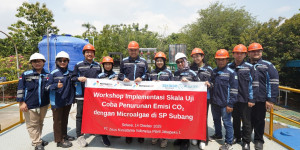PT Patra Drilling Contractor (PDC), a subsidiary of state-owned company PT Pertamina Drilling Services Indonesia (PDSI), supports PT Pertamina Hulu Energi’s (PHE) program to reduce CO2 emissions/Net Zero Emissions (NZE) through the development of ELAM (Natural Energy) Microalgae innovations.
The project, pursued in cooperation with with PT Algatek Karbon Nusantara, a subsidiary of PT Zeus Kimiatama Indonesia Plant Jababeka I (Zekindo), is located at the Subang Collection Station (SP Subang), in Subang, West Java.
Through a biotechnological approach, microalgae are harnessed for their natural ability to absorb CO2, enabling them to function as a natural balancer of the Earth’s atmosphere. This initiative reflects PHE and PDC’s concrete steps toward NZE, creating synergy between science, nature, and future energy.
“By utilizing microalgae, we not only reduce CO2 emissions but also utilize them as soil enhancers, transforming barren land into green spaces,” Doli Hasyda Bragoba, Senior Spec Innovation Process & Facility Manager at PHE, said on Wednesday, November 12, 2025.
PDC is currently cultivating and fabricating microalgae at the Cikarang Workshop for a trial-scale implementation of CO2 reduction with microalgae at the Subang SPG, with a design capacity of 1 Million Standard Cubic Feet per Day (MMscfd) and a CO2 absorption capacity of 0.2 MMscfd.
The trial-scale implementation plan has already achieved several milestones, including laboratory-scale microalgae absorption capacity, microalgae species that meet the specifications for the flue gas composition at the Subang SPG, and the ratio of soil enhancer to fertilizer to soil. A risk assessment workshop will then be held for the implementation and fabrication of a single-stage photobioreactor system.
As part of addressing the challenges of global climate change, this collaboration offers an alternative solution for reducing CO2 emissions and also presents new opportunities for the green economy.
“We will also apply the circular economy concept in the development of microalgae innovation,” Andipa Damatra, PDC Project Manager, said.
In practice, the microalgae biomass produced from CO2 absorption will be processed into high-value products, one of which is a soil enhancer that increases fertility and improves soil structure.
“This activity presents a potential collaboration in implementing green energy with microalgae, which can transform emissions into new green life on the soil and support ESG programs,” Doli said.
As a biomass derived from photosynthesis, microalgae will become saturated over time and can be processed into biofuel, organic fertilizer, food ingredients, and sustainable industrial products.
The pilot-scale implementation project for CO2 emission reduction with microalgae at the Subang SP can serve as a national benchmark for the application of green energy technology in Indonesia.
“We hope this project will run smoothly and produce significant results in achieving the CO2 emission reduction target, while strengthening our commitment to sustainable development,” Andipa said.
The Subang Field is one of the fields managed by Pertamina EP Asset 3, a business unit of PT Pertamina EP (PEP), a subsidiary of PT PHE, a production sharing contract contractor under the supervision and coordination of the Upstream Oil and Gas Regulatory Task Force (SKK Migas). There are 10 Gathering Stations (SP) and three test units at the Subang Field spread across two regencies, Karawang and Subang, West Java.
The Subang SP is unique compared to other SPs in that it has a CO2 removal plant. In addition to the Subang SP, another CO2 removal plant is located at the North Cilamaya SP, Karawang.
The designed CO2 removal capacity at the Subang SP is 100 MMscfd per train. There are two trains in the Subang SP. The CO2 removal at the Subang SP is also designed to reduce CO2 levels from 23 percent to 5 percent. This is because the CO2 content in the natural gas at the Subang SP is around 23 percent, requiring treatment before the gas can be sold to consumers.
Current oil and gas production at the Subang SP is approximately at 139 MMscfd and 120 BCPD (barrels of condensate per day). Fluids from the wells (gas and liquids) will be separated by the Subang SP with a separator. The separated gas enters a gas compressor system to increase its pressure, then enters a CO2 removal plant to remove carbon dioxide and then enters a Dehydration Plant (DHP) to remove H2O.
Subang District also operates the Pasirjadi SP and the Tunggulmaung Test Unit. Subang District manages a total of 38 oil and gas wells. These include 21 wells at the Subag SP (13 producing wells, 8 non-producing wells), 14 wells at Pasirjadi (two producing wells, 10 non-producing wells, and two pressure maintenance injection wells), and two wells at Tunggulmaung.
